Intercultural cities: good practice examples

The first step is the adoption (and implementation) of strategies that facilitate positive intercultural encounters and exchanges, and promote equal and active participation of residents and communities in the development of the city, thus responding to the needs of a diverse population. The Intercultural integration policy model is based on extensive research evidence, on a range of international legal instruments, and on the collective input of the cities member of the Intercultural Cities programme that share their good practice examples on how to better manage diversity, address possible conflicts, and benefit from the diversity advantage.
This section offers examples of intercultural approaches that facilitate the development and implementation of intercultural strategies.
Intercultural Education as a part of a School Curriculum
Purpose: To teach school kids values of tolerance, respect to different cultures, and ethnic conflicts prevention Process: In 2017, Sumy school #18 officially established intercultural education as...
The Successful Roma of Pavlohrad
Purpose: Integration of Roma population into the city's social life; encouraging Roma community, fighting negative stereotypes. Stimulus/Rationale: Pavlohrad has a large community of Roma people,...
Participation Scheme
Purpose: Working in partnership and residents’ consultations are at the core of Swansea’s way of planning and evaluating policies. Process: In Swansea priorities, plans, budget, social services,...


